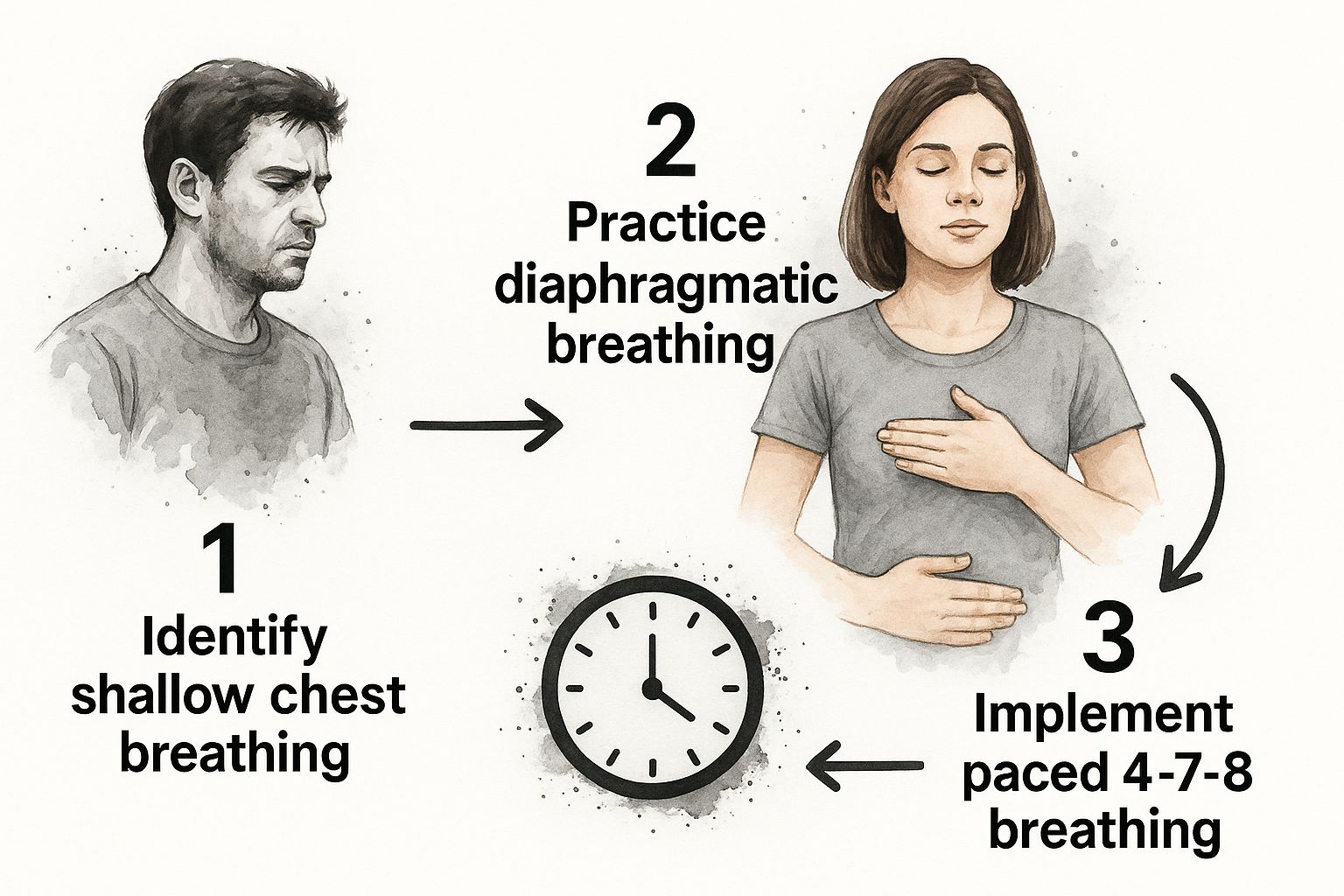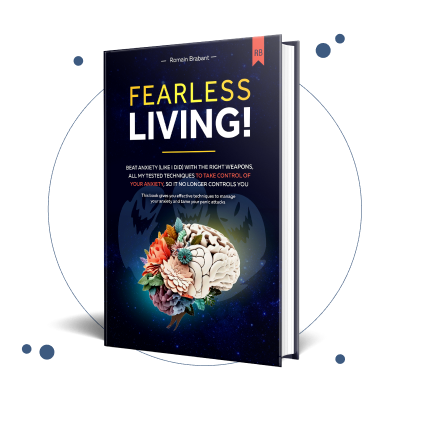
Yes, stress and anxiety can absolutely cause breathing problems. It's a terrifying feeling—that sudden shortness of breath, a tight chest, or the sensation that you just can't get enough air. But as scary as it is, it's also a common and, importantly, manageable physical symptom of anxiety.
This connection is real, and truly understanding it is the first and most powerful step toward finding your calm again and living a life free from panic.
Your Experience Is Real, and You Can Heal

If you've ever felt your breath catch in your throat during a wave of worry, you are far from alone. Anxiety disorders affect a huge portion of the population. Globally, about 4.4% of people—around 359 million individuals in 2021—live with an anxiety disorder, and many of them know the feeling of hyperventilation and strange breathing patterns all too well.
The sensation is deeply unsettling, but it has a logical explanation. Think of your body's internal alert system as a super-sensitive smoke alarm. It's designed to protect you from real danger, but sometimes, it goes off for something minor, like a piece of burnt toast.
When you feel stressed or anxious, your brain can't always tell the difference between a real threat and a worrisome thought. It hits the panic button anyway, flooding your body with adrenaline to prepare you to fight or flee. The good news is, you can learn to recalibrate this alarm system.
The Anxiety-Breathing Feedback Loop
This initial physical response often kicks off something called the anxiety-breathing feedback loop. It's a frustrating cycle that can make you feel powerless, but I promise you, breaking it is entirely possible.
Here’s how it works:
- A stressful thought pops up, and your breathing instantly becomes shallow and quick.
- You notice the change in your breathing, which triggers a new wave of worry. "What's wrong with me?"
- This fresh anxiety makes your breathing even worse, which seems to confirm your fear that something is seriously wrong.
This cycle is fueled by hyper-focusing on the physical sensations. The more you monitor your breathing, the more unnatural and difficult it feels, creating a loop that can quickly escalate into a full-blown panic attack. It's crucial to understand that while these feelings are alarming, they are not dangerous. They are just your body’s alarm system doing its job a little too well.
A great starting point is identifying what sets this cycle in motion in the first place. Exploring the https://anxietychecklist.com/common-anxiety-triggers can shed some light on what's pulling your "fire alarm."
The most important thing to remember is this: understanding the link between your mind and your breath is the first, most powerful step toward regaining control. You can learn to recalibrate your body's alarm system and find lasting peace.
Common Breathing Sensations Caused by Anxiety
When anxiety takes hold, it can create a variety of strange and frightening breathing sensations. Recognizing them as symptoms of anxiety—not a dangerous medical emergency—is the key to breaking the cycle of panic and starting your journey to healing.
Here’s a quick rundown of what you might feel and why it's happening.
| Symptom | What It Feels Like | Why It Happens (Simplified) |
|---|---|---|
| Shortness of Breath | Like you can't get a deep, satisfying breath, no matter how hard you try. | Your chest muscles tighten up due to stress, making it feel harder to expand your lungs fully. |
| Hyperventilation | Rapid, shallow breathing that can make you feel dizzy or lightheaded. | Your body's "fight or flight" response is trying to get more oxygen, but it overdoes it. |
| Chest Tightness | A heavy, constricted, or crushing sensation around your chest. | Adrenaline causes the muscles between your ribs to tense up, creating pressure. |
| Feeling of Smothering | The terrifying sensation that you're suffocating or can't get any air in. | A combination of muscle tension and a hyper-focus on your breath creates a powerful illusion. |
| Constant Yawning | The need to yawn frequently, as if trying to catch your breath. | This is your body's attempt to regulate oxygen and carbon dioxide levels when your breathing is off. |
Seeing these sensations laid out can be incredibly validating. You're not imagining it, and you're not in danger. It's just your nervous system on high alert. With the right tools, you can teach it to stand down and find a new, calmer way of being.
How Your Body Connects Stress and Breathing

To really understand why a stressful thought can make you feel like you can't breathe, we need to look at your body's ancient, hardwired survival system. It’s a powerful internal alarm designed to protect you from immediate, physical danger.
When your brain senses a threat—it doesn't matter if it's a real danger or just an overwhelming anxious thought—it instantly hits the panic button, activating the sympathetic nervous system. Think of this as your body's accelerator pedal. It triggers the famous "fight-or-flight" response.
This response floods your bloodstream with a cocktail of stress hormones like adrenaline and cortisol. Their one and only job is to prep you for intense physical action. Your focus sharpens, your heart races, and—most importantly for us here—your breathing pattern completely changes.
If you want to dive deeper into this process, our complete guide to the fight-or-flight response breaks it all down.
Hyperventilation: The Body's Overzealous Helper
As adrenaline surges, your breathing automatically gets faster and shallower. The logic is simple: get more oxygen to your muscles, fast, so you can either fight off a predator or run for your life. In a genuine life-or-death scenario, this is an incredible feature.
But when the "threat" is a looming deadline or a sudden wave of panic, you don't actually use that extra oxygen by running or fighting. This mismatch leads to a state of over-breathing, better known as hyperventilation.
Even though it feels like you're desperate for air, hyperventilation actually causes you to have too much oxygen and, crucially, too little carbon dioxide (CO2) in your blood. This chemical imbalance is the real culprit behind many of the most frightening physical symptoms of anxiety.
Understanding this is a game-changer. Your body isn't failing; it's just following an ancient script that doesn't fit a modern problem. This knowledge shifts the power from the fear back to you, empowering you to rewrite that script.
Why Hyperventilation Feels So Scary
That drop in CO2 levels changes your blood's pH, making it more alkaline. This tiny chemical shift is what unleashes a whole host of alarming sensations that can easily convince you that you're in serious medical trouble.
This disruption is directly responsible for:
- Dizziness and Lightheadedness: The changes in blood chemistry affect blood flow to the brain, causing that woozy, unstable feeling.
- Tingling or Numbness: You might feel this in your hands, feet, or around your lips. It's a classic result of nerve sensitivity sparked by the pH imbalance.
- "Air Hunger": This is the most confusing symptom of all. Despite breathing too much, you feel like you’re suffocating. That's because your brain's respiratory center is desperately trying to correct the low CO2 levels.
These symptoms aren't random; they are the logical, predictable outcome of a physiological process. They feel terrifying, yes, but they are not life-threatening. Recognizing them for what they are—a temporary overreaction from your body's defense system—is the first and most critical step toward breaking the cycle and teaching your body it's safe to stand down for good.
Recognizing Anxiety-Related Breathing Patterns

Learning to spot the exact ways anxiety affects your breathing is the first real step toward getting back in the driver's seat. Think of it like becoming a detective for your own body. Once you can name the pattern, you can start to dismantle it and build new, healthier habits.
These feelings are so much more than just "shortness of breath." They're often sneaky, persistent habits that keep your nervous system stuck on high alert.
By recognizing these signs, you strip away their power. They stop being mysterious, terrifying events and become predictable symptoms you know how to handle. This awareness is how you start teaching your body that it's safe, clearing a path toward a life free from the constant fear of your next breath.
Beyond Obvious Shortness of Breath
Anxiety-related breathing issues aren't always dramatic, movie-style gasps for air. Sometimes, they're much quieter—subtle but constant patterns of dysfunctional breathing that can follow you around all day. Paying attention to these signals is key to your healing.
You might notice habits like:
- Constant Sighing or Yawning: This is your body's unconscious attempt to hit the reset button on your breathing, trying to get that one satisfying, deep breath it can't seem to find.
- "Air Hunger": A deeply frustrating feeling that you just can't get a full, deep, or complete breath, no matter how hard you inhale.
- Chest Breathing: Taking shallow breaths that only move your chest and shoulders, instead of engaging your diaphragm. It's an inefficient way to breathe that keeps your muscles tense.
- Breath-Holding: Without even realizing it, you might hold your breath for short bursts when you're stressed, focused, or startled.
These patterns can trap you in a chronic state of low-grade hyperventilation, keeping you perpetually on edge. This is especially true for anyone who's felt the intense respiratory symptoms detailed in our guide on what happens during a panic attack.
Recognizing these patterns isn't about finding more things to worry about. It's about gathering intel. Every time you notice a sigh or a tight chest, you have a new opportunity to respond with a calming technique instead of more fear, actively building a new, more peaceful reality.
Distinguishing Patterns and Seeking Clarity
Chronic stress is a well-known trigger for respiratory problems. To give you an idea, a massive survey found that 72% of adults regularly felt financial stress and 60% dealt with stress at work—both are major contributors to dysfunctional breathing. This connection is why getting a handle on your symptoms is so critical, especially when respiratory diseases are among the leading causes of death worldwide, with anxiety often making things much more complicated. You can dive deeper into how widespread stress impacts health and breathing.
But here’s the most important part: while these feelings are classic signs of anxiety, you absolutely must get an accurate diagnosis. Always talk to a doctor to rule out any underlying physical conditions like asthma, allergies, or heart issues.
Once other medical causes are off the table, you can move forward with confidence, knowing you’re tackling the real source of the problem. That clarity is liberating. It allows you to shift your focus from worrying about your physical health to actively healing your mind and body from anxiety—paving the way for a panic-free life.
How to Regain Control with Calming Breathwork
Realizing your breathing problems are tied to anxiety is a massive first step. But this is where the real work—and the real healing—begins. You can actively retrain your body's stress response, and your most powerful tool is something you have with you every single moment: your breath.
By learning a few simple, intentional breathing techniques, you can send a direct signal to your brain, telling it that the danger has passed and it's safe to stand down from fight-or-flight mode. Think of it as finding the manual override switch for your body's internal alarm system.
These exercises aren't just a quick fix. They're a skill you build over time. With consistent practice, you're literally creating new neural pathways, making it easier and more automatic for your body to choose calm over panic. This is how you build real, unshakable resilience and create a life where you feel safe and in control.
The Power of Diaphragmatic Breathing
When we're anxious, we tend to take short, shallow sips of air from our chest. It’s a tense, inefficient way to breathe that basically tells our nervous system to stay on high alert.
The antidote is diaphragmatic breathing, often called belly breathing. This technique engages your diaphragm, the large, dome-shaped muscle at the base of your lungs. It’s a much deeper, more efficient way to breathe that directly activates the parasympathetic nervous system—your body’s “rest and digest” mode. It physically slows your heart rate, lowers your blood pressure, and sends a powerful "all clear" signal to your brain.
The simple act of changing how you breathe can interrupt the anxiety-breathing feedback loop in seconds. It is one of the most direct ways to communicate with your nervous system and reassure it that you are safe.
This infographic breaks down the simple flow from identifying anxious breathing to implementing calming techniques.

This visual shows a clear, actionable path from a state of distress to one of calm control.
Three Powerful Breathing Exercises for Anxiety Relief
Having a few go-to breathing exercises in your back pocket can make all the difference. The key is to practice them when you're already calm, so they become second nature when stress hits. Think of it as a fire drill for your nervous system.
Here’s a quick guide to three incredibly effective techniques that can help calm your nervous system and get your breathing back on track.
| Technique | Step-by-Step Instructions | When to Use It |
|---|---|---|
| Basic Belly Breathing | 1. Sit or lie down comfortably. Place one hand on your chest and the other on your stomach. 2. Inhale slowly through your nose for a count of 4. Feel your stomach expand while your chest stays relatively still. 3. Exhale slowly through your mouth for a count of 6, feeling your stomach fall. Repeat for 5-10 minutes. |
Perfect for daily practice to build resilience or when you feel the first signs of stress creeping in. |
| Box Breathing | 1. Inhale slowly through your nose to a count of 4. 2. Hold your breath for a count of 4. 3. Exhale slowly through your mouth for a count of 4. 4. Hold your breath at the end of the exhale for a count of 4. Repeat the cycle. |
Excellent for when your mind is racing or you feel overwhelmed. The structure gives your brain something to focus on besides the anxiety. |
| 4-7-8 Breathing | 1. Sit with your back straight. Place the tip of your tongue against the ridge of tissue just behind your upper front teeth. 2. Exhale completely through your mouth, making a whoosh sound. 3. Close your mouth and inhale quietly through your nose to a mental count of 4. 4. Hold your breath for a count of 7. 5. Exhale completely through your mouth, making a whoosh sound to a count of 8. This is one breath. Repeat the cycle 3 more times for a total of 4 breaths. |
A powerful sedative for the nervous system. Use it when you need to de-escalate quickly from high anxiety or to help you fall asleep. |
Find a technique that feels right for you and try to weave it into your daily routine. For a deeper dive into more methods, you can explore these powerful breathing exercises for anxiety.
By doing this, you're not just managing symptoms—you're fundamentally changing your relationship with anxiety and taking your power back.
Building a Lifestyle That Supports Calm Breathing
While mastering breathwork is your direct line to calming anxiety in the moment, lasting peace comes from building a lifestyle that supports your nervous system from the ground up. Think of it as creating a strong foundation—one that reduces your overall stress load and makes those anxiety-related breathing problems less frequent and intense when they do show up.
This isn't about a quick fix. It's about building resilience by focusing on a few key areas. When you do, you help regulate your body's stress response and foster a sense of stability. Calm breathing can become your natural default state, not something you constantly have to fight for.
Grounding Yourself in the Present Moment
When anxiety strikes, your mind loves to spiral into future worries or past regrets, yanking you away from the safety of the present. Grounding techniques are simple but incredibly powerful tools designed to anchor you firmly in the here-and-now. They interrupt anxious thought loops before they can trigger physical symptoms like shortness of breath.
One of the most effective and easy-to-remember methods is the 5-4-3-2-1 technique. You can do it anywhere, anytime:
- 5: Look around and acknowledge FIVE things you can see. It could be a pen on your desk, a crack in the ceiling, or a car driving by.
- 4: Bring your attention to FOUR things you can physically feel. This might be the texture of your shirt, the smooth surface of your phone, or the solid ground beneath your feet.
- 3: Listen for THREE distinct sounds. Maybe it's the hum of a refrigerator, distant traffic, or the sound of your own quiet breathing.
- 2: Identify TWO different things you can smell. Perhaps it's the scent of coffee brewing or the clean smell of soap on your hands.
- 1: Finally, name ONE thing you can taste. This could be the lingering flavor of your morning toothpaste or just a simple sip of water.
By systematically engaging all your senses, you force your brain to shift its focus from internal worry to external reality. This simple act can stop an anxiety spiral dead in its tracks, proving you have the power to guide your attention back to a place of safety.
Nourishing Your Body to Calm Your Mind
The connection between your gut and your brain is no joke. What you eat, how you move, and how well you sleep have a direct, measurable impact on your body’s stress response and your overall mental well-being.
Regular physical activity is one of the best ways to burn off excess stress hormones like adrenaline. At the same time, prioritizing quality sleep gives your brain and body the essential time they need to repair and reset. A balanced diet also plays a huge role; our guide to lifestyle and diet changes for anxiety management dives deep into specific strategies.
To cut down on daily stressors, you could even learn how to meal prep your way to a simpler week. It might sound small, but reducing decision fatigue around food can make a surprisingly big difference in supporting your goal of calm, easy breathing.
When It’s Time to Get Professional Support for Breathing Issues
Breathing exercises and lifestyle shifts are fantastic tools for getting a handle on anxiety-related breathing trouble. But sometimes, self-help strategies just aren't enough—and that’s completely okay. Knowing when to reach out for professional support isn’t a sign of weakness. It’s a brave and powerful step toward real, lasting healing.
In fact, asking for help is the ultimate act of taking control. It means you’re ready to invest in your well-being and finally break free from the cycle of panic.
Clear Signs It’s Time to Talk to a Professional
While anxiety is a super common reason for breathing difficulties, it’s critical to rule out other medical issues first. Always start with a healthcare provider to get an accurate diagnosis. It's especially important to know the difference between anxiety symptoms and other problems; for example, understanding medical conditions like hypoxia can make it clear when you need immediate medical attention.
It's time to seek support if you experience any of these:
- Breathing difficulties that come with chest pain, fainting, or severe dizziness.
- Symptoms that consistently blow up your daily life, making work, school, or relationships feel impossible to manage.
- A persistent feeling that anxiety and panic are running the show, no matter how hard you try to fight back.
Finding Your Path to a Panic-Free Life
There are effective, evidence-based treatments that get to the root causes of anxiety. One of the most successful is Cognitive Behavioral Therapy (CBT), a type of talk therapy that teaches you how to spot, challenge, and reframe the negative thought patterns that set off your physical anxiety symptoms.
But even though CBT is highly recommended, getting access to care can be tough. In reality, only about 27.6% of people with anxiety disorders around the world get any kind of treatment, often due to stigma and a shortage of trained providers. This gap is a huge reason why finding accessible, scalable options is so important. To learn more, read the full research on treatment accessibility and interventions.
Reaching out to a doctor or therapist opens the door to proven strategies that can help you live a panic-free life. It is the hopeful next step on your journey to reclaiming your peace and breathing easy once again.
Questions We Hear All The Time
Can Anxiety Breathing Problems Cause Permanent Damage?
It's a terrifying feeling, but let's be crystal clear: breathing problems from anxiety do not physically damage your lungs.
The tightness, the shortness of breath—it all stems from your body’s temporary 'fight-or-flight' response. It's a system glitch, not a structural problem with your lungs. With practice and the right tools, you can absolutely learn to manage this response and live without fear of these sensations.
How Long Does It Take for Breathing Exercises to Work?
In the middle of an anxious moment, you can start feeling calmer within just a few minutes of focused breathing. That's the immediate relief.
But the real, lasting change comes from consistent daily practice, even if it’s just for 5-10 minutes. Think of it like going to the gym for your nervous system. The more you practice these techniques when you're calm, the more automatic and powerful they become when you actually need them. You're literally retraining your brain to choose calm over panic.
This is a hopeful journey. With the right tools and consistent practice, you are not just managing symptoms—you are actively building a foundation for a panic-free life where you are in control.
How Do I Know If It's Anxiety or a Heart Attack?
This is such a common and completely valid fear. The physical symptoms can feel terrifyingly similar.
A key difference is that panic attack symptoms often hit their peak intensity within 10 minutes and might come with other signs like tingling or trembling. A heart attack, on the other hand, is usually a persistent, crushing pressure that can spread to your arm or jaw.
But listen, never, ever try to self-diagnose this. If you have even the slightest doubt, especially if you have risk factors for heart disease, seek emergency medical attention immediately. It's always better to be safe.
At The Anxiety Checklist, we believe you can absolutely break free from the cycle of panic. Our Fearless Living system is a step-by-step guide designed to help you understand anxiety, manage your symptoms, and build a life defined by confidence, not fear. Get started here.

